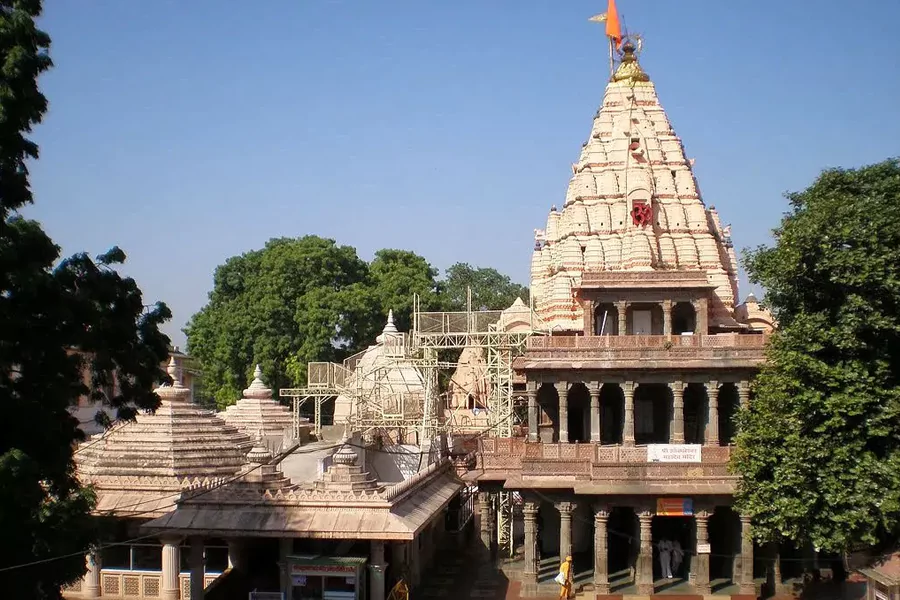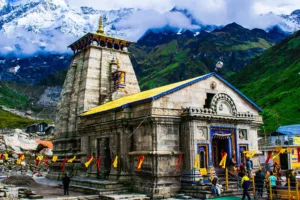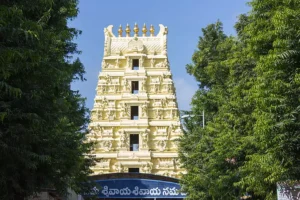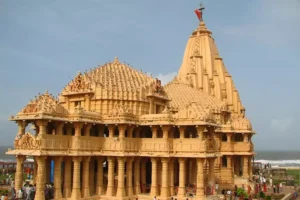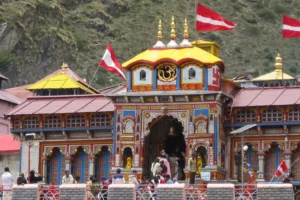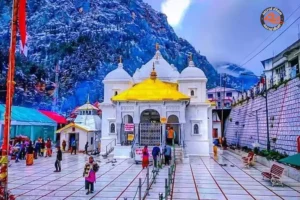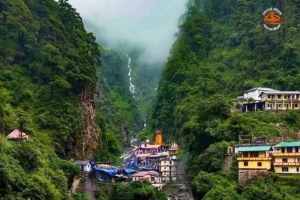Mahakaleshwar Temple
About Shri Mahakaleshwar Jyotirlinga Temple Ujjain
Shri Mahakaleshwar Temple is commonly called Mahakal temple. It stands as one of India’s most revered Hindu temples dedicated to Lord Shiva. This magnificent temple holds distinction among the 12 Jyotirlingas across India. It sits majestically along the holy River Shipra in Ujjain, Madhya Pradesh. Devotees and spiritual seekers continuously flock to this sacred Shiv Temple (mandir) of Ujjain. They are drawn by its extraordinary history and divine significance. The temple gains additional prominence through the grand Simhastha fair (Kumbh Mela). This fair occurs every 12 years and attracts millions of pilgrims from around the globe.
The name Mahakal combines two powerful Sanskrit words. Maha means “great,” and Kaal represents “Time and Death.” Hindu traditions recognize Lord Shiva as the supreme deity governing death and time. This earns him the title Mahakaleshwar. This divine association gives the temple its sacred name, Mahakal (Mandir) Temple.
The Legends of Mahakaleshwar Jyotirlinga
Hindu scriptures describe the Mahakal lingam as a self-manifested divine form. It generates spiritual energy (Shakti) from its core. This unique characteristic establishes Mahakaleshwar as Swayambhu. This term means self-born or self-existent.
The lingam at Mahakaleshwar displays a rare feature – it faces south. This earns the designation Dakshina Mukhi. This southward orientation makes it exceptionally unique among Shiva temples.
The Shiva Purana narrates how Lord Shiva manifested as an endless pillar of blazing light. This light is called Jyotirlinga and pierced through the universe. The sacred locations where Shiva appeared as this divine column of fire became the revered jyotirlinga shrines.
Ancient Puranas confirm Mahakal temple as one of the 12 Jyotirlingas. Lord Shiva exists here in his luminous form. Devotees believe that sincere worship at this holy site cleanses all sins and grants liberation.
History of Mahakaleshwar Temple, Ujjain
The Varaha Purana identifies Mahakaleshwar’s location at the earth’s central point (Nabhi). This location is specifically at Ujjain.
Ancient chronicles tell of King Chandrasena of Ujjain, a sincere devotee of Lord Shiva who dedicated his life to prayer and worship. During one of his prayer sessions, a young boy named Shrikhar approached, requesting permission to join the worship. The king refused and sent the boy to the city’s outskirts.
At the city’s edge, Shrikhar discovered a dangerous plot by enemy rulers Ripudamana and Singhaditya, who planned to attack Ujjain with help from the demon Dushanan. Realizing the imminent threat to his beloved city, Shrikhar immediately offered prayers to Lord Shiva, pleading for divine protection. A devoted priest named Vridhi joined these urgent prayers for Ujjain’s safety.
When the demonic forces launched their fierce attack and seemed ready to destroy the city, Lord Shiva responded to his devotees’ heartfelt pleas. He manifested in his powerful Mahakal form and successfully defeated the invading demons, saving Ujjain from destruction. Touched by the unwavering devotion of Shrikhar and Vridhi, Lord Shiva decided to establish his permanent residence in Ujjain as a Shivlinga, thus creating the sacred Mahakaleshwar temple that continues to bless devotees today.
Mahakaleshwar Jyotirlinga Temple in Ujjain
Mahakaleshwar Temple Darshan Timings
The Mahakal Temple welcomes devotees from 4 a.m. to 11 p.m. daily, hosting numerous religious ceremonies throughout these hours. Visitors can participate in various sacred rituals, including morning prayers, midday worship, and evening aarti. Unlike many temples that close during afternoon hours for lunch breaks, the Mahakaleshwar temple maintains continuous operations without any daytime interruptions.
|
|
||
|---|---|---|
| Ritual | From | To |
| Darshan | 4:00 AM | 11:00 PM |
| Bhasma Aarti | 4:00 AM | 6:00 AM |
| Morning Pooja | 7:00 AM | 7:30 AM |
| Evening Pooja | 5:00 PM | 5:30 PM |
| Shree Mahakaal Aarti | 7:00 PM | 7:30 PM |
Bhasma Aarti at Mahakaleshwar Jyotirlinga
The world-famous Bhasma Aarti at Mahakaleshwar Temple occurs daily, creating a spiritually charged atmosphere that attracts devotees worldwide. This sacred ceremony commences precisely at 4:00 a.m., serving as the divine wake-up call for Lord Shiva. Historical records indicate that ancient times saw the use of funeral ashes in this ritual, but contemporary practices have evolved to use specially prepared ash from sacred cow dung.
For detailed information about bhasma aarti rules and online booking procedures for Bhasma aarti, devotees can visit: https://shrimahakaleshwar.com/bhasmarti
The architecture of the Mahakal Temple
Construction of the Mahakal temple took place during the fourth and fifth decades of the eighteenth century A.D. The architectural design masterfully combines Bhumija, Maratha, and Chalukya styles, creating a visually stunning and spiritually significant structure. The temple complex houses three additional sacred temples dedicated to Lord Ganesha, Goddess Parvati, and Nagchandreshwar. The Nagchandreshwar temple opens its doors to pilgrims and visitors exclusively during the auspicious Nag Panchami festival.
The magnificent structure and divine glory of the Mahakal temple in Ujjain have captivated Shiva devotees since ancient times, drawing millions of spiritual seekers to experience its sacred energy.
Shri Mahakal Lok Corridor
Ujjain has witnessed the implementation of the ambitious ‘Mahakal Lok’ project, designed to boost tourism, preserve ancient heritage, and offer world-class modern amenities to pilgrims. The project’s first phase has reached completion, transforming the spiritual experience for visitors.
The Shri Mahakal Lok Corridor extends over 900 meters, surrounded by the historic Rudrasagar Lake, which forms an integral part of this development initiative. Visitors entering the corridor encounter 108 magnificent pillars, approximately 200 detailed statues, and artistic murals that beautifully narrate Lord Shiva’s divine stories.
The pillars, sculptures, murals, fountains, and landscaped parks glow with vibrant lights during nighttime, creating a mesmerizing spiritual ambiance. The complex also features a dedicated Bharat Mata Mandir where the stirring Vande Mataram song resonates daily at 8 pm. Following this musical tribute, powerful chants of Bharat Mata Ki Jai and Vande Mataram fill the air, igniting patriotic fervor in every visitor’s heart.
Mahakal Sawari
The grand procession of Shri Mahakaleshwar Baba (Mahakal Ki Sawari) takes place during the sacred months of Shravan and Bhado. The ceremony begins with a spectacular highlight – a formal police contingent presents a ceremonial salute to Rajadhiraj (Mahakaleshwar Baba) outside the temple premises, marking the procession’s official commencement.
During this divine Sawari, devoted followers carry the sacred Mahakal idol in an ornate palanquin on their shoulders, creating a moving temple of faith. Participants fill the atmosphere with devotional songs, energetic dancing, and heartfelt prayers, seeking Mahakal Baba’s divine blessings. The procession culminates at the holy Shipra Ghat, where priests perform special rituals to honor Lord Shiva.
The final procession bears the prestigious title of the royal ride of Mahakal, known as Baba Mahakal Ki Shahi Sawari.
Maha Shivratri at Mahakal Temple, Ujjain
While Maha Shivratri celebrations occur throughout India, Ujjain’s observance offers an unparalleled spiritual experience that visitors must witness. Mahakal temple holds the unique distinction of celebrating Shiva Navratri for nine consecutive days, setting it apart from other Shiva temples.
Throughout these nine sacred days, dedicated Hindu priests perform special abhishek ceremonies and continuous mantra chanting to honor Lord Shiva. During the festival period, priests also employ elaborate Shringaar (decorative worship) to showcase different divine forms of Lord Shiva, highlighting his celestial attributes with remarkable clarity and devotion.
The ninth and final day of Shiva Navratri reaches its crescendo with magnificent celebrations featuring special Panchamrit Abhishek and Bhasmarti Puja at the Mahakal temple. Devotees travel from across the nation to participate in these sacred rituals, creating an atmosphere of unmatched spiritual energy.
How To Reach Mahakal Temple Ujjain
Ujjain, the sacred home of Mahakaleshwar Temple, enjoys excellent connectivity through multiple transportation modes. Here are convenient ways to reach the Mahakal Temple in Ujjain:
- By Air: Devi Ahilya Bai International Airport in Indore serves as the nearest airport, located 55 km away. This airport maintains regular flight connections to major Indian cities including Delhi, Mumbai, Pune, Bhopal, Hyderabad, Ahmedabad, Nagpur, Raipur, and Kolkata.
- By Rail: Ujjain railway station operates from the town’s central location, providing connectivity to major cities throughout the state and across India through both local and express train services. The main bus stand at Dewas Gate sits just 600 meters from the railway station.
- By Road: Direct bus services, both private and government-operated, run regularly between Ujjain and cities like Indore, Omkareshwar, Maheshwar, Burhanpur, Dhar, and Bhopal. The city operates two primary bus terminals. The Dewas Gate bus stand occupies a central location, offering easy access to various transportation options including auto-rickshaws, tempos, cycle rickshaws, and taxis. The second terminal, Nanakheda Bus Terminus, operates approximately 5 kilometers from the city center.
Best time to visit Ujjain
Ujjain welcomes visitors throughout the year, accommodating pilgrims regardless of season. However, optimal visiting periods align with major festivals such as Mahashivratri, Mondays during the Savan month, Nag Panchami, and particularly during the annual Kartik Mela and the once-in-12-years Kumbh Mela celebrations.


